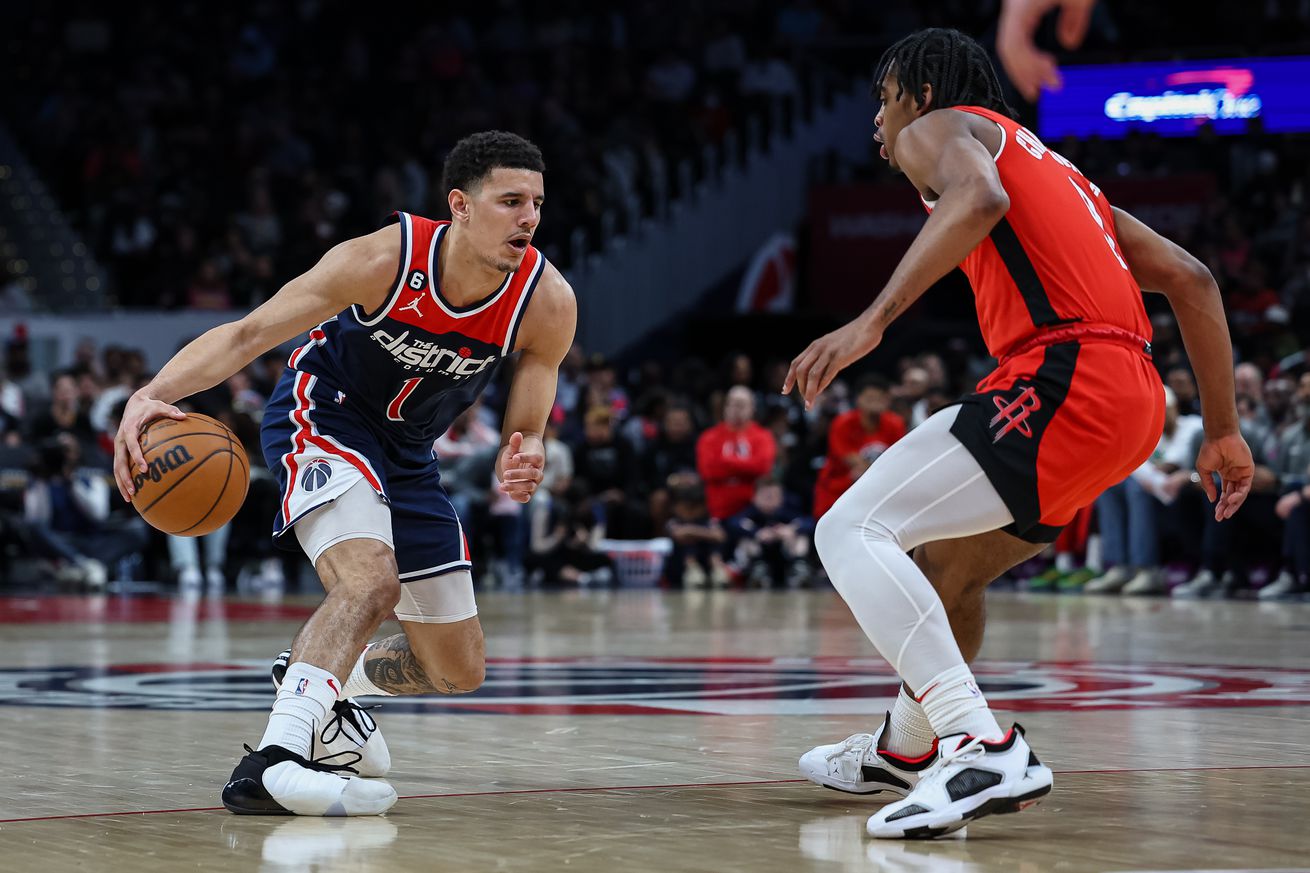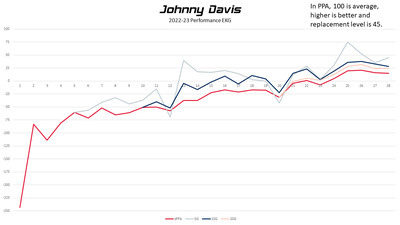
Stats, analysis and commentary
I do not envy the marketing team for the Washington Wizards. What sells in the NBA is wins. Washington has posted a losing record for five consecutive years. They haven’t cracked 50 wins since 1978-79 — 44 seasons.
During that 44-season timeframe, the Wizards/Bullets have a record of 1,566-2,056 — a winning percentage of 43.2%. That ranks 27th among the 30 NBA teams. The only franchises with worse records since Washington’s last 50+ win season: the Los Angeles Clippers (42.3% winning percentage) and the Minnesota Timberwolves (40.2%).
If you can’t sell wins, the next best marketing strategy is hope. It’s the “hey look at our young players who will surely get better and start winning” play. Really, it’s still selling wins — future wins vs. present ones.
But the draft day whiffs of the past four years have left the “youngsters” shelf in the team pantry a bit bare. Maybe there’s enough for a meal if you’re starving, but it won’t taste good or provide much nourishment.
The Wizards are giving it a shot with some social media promotion of 2022 first round pick Johnny Davis.
There are highlights.
built some momentum to carry into year 2 #DCAboveAll x @JohnnyDavis pic.twitter.com/sA1SU3RvdJ
— Washington Wizards (@WashWizards) April 26, 2023
And stats.
ended his rookie season on a strong note #DCAboveAll x @JohnnyDavis pic.twitter.com/C0zRNNvsLE
— Washington Wizards (@WashWizards) April 26, 2023
And photos too, which I won’t post here.
You. Will. Believe.
Oh wait, they didn’t post that last one.
The problem? Well, I’m not getting paid to promote the team, and I’ve spent too many decades watching the same false narratives get told. Like “ended his season on a strong note.”
So, instead of peddling false hope with silly stats, let’s take a real look at Davis’ rookie year and maybe close with some real reasons for hope.
Let’s start with this: Davis had a terrible rookie season. I don’t mean bad for a 10th overall pick. I mean, just bad. Bad for a second round pick. Bad for an undrafted free agent. Bad for an injury replacement signed to a 10-day contract.
In that regard, Davis joins the franchise’s astounding record of crappy drafting. This isn’t just a Tommy Sheppard issue. I checked my database for previous Washington rookies. My database begins in the 1977-78 season. It contains 70 Washington rookies who played at least 250 minutes in their rookie year with the team.
Here’s the complete list of Washington rookies who rated above average in my Player Production Average metric:
- Jeff Ruland, 1981-82 — PPA: 119 (in PPA, average is 100 and higher is better)
- Tom Gugliotta, 1992-93 — PPA: 110
- Greg Ballard, 1977-78 — PPA: 105
That’s it. Out of 70 rookies. In fairness to the franchise, Mitch Kupchak was probably above average as a rookie. But his first season was 1976-77 — a year before time starts in my database.
To be sure, picking young players is an inexact science. But still.
We’re talking 45 years and six different executives — seven if we count Wes Unseld’s two stints separately. He was the team’s top executive from 1996 to 2000. Michael Jordan served from 2000 to 2001, and Unseld resumed the role until Ernie Grunfeld took charge in 2003.
It’s a staggering record of draft futility.
They did draft/acquire youngsters who turned into good players through the years, of course. But the last rookie who cracked league average in his first season played 30 years ago.
To answer the inevitable question: no, not John Wall. Not Bradley Beal. Though both were close. Not Juwan Howard or Gheorge Muresan or Rasheed Wallace or Jeff Malone or Richard Hamilton or Dave Corzine or Rick Mahorn or Rui Hachimura or Deni Avdija or Muggsy Bogues or Roger Phlegley or Johnny Davis.
Out of the 70 rookies, 23 rated below replacement level. And people complain I’m too negative about this outfit?!
Any way I look at it, Davis had a bad rookie season. His PPA was 15, which is below replacement level and ties with Otto Porter for third worst among Wizards/Bullets since 1977-78. Only Phil Walker (-12) and Bryan Warrick (5) rated worse among franchise rookies who got at least 250 minutes.
Per 100 team possessions, Davis averaged 18.4 points, 7.1 rebounds, 3.2 assists, 1.1 steals and 0.9 blocks. That’s below average across the board. His offensive rating was 90, which was more than 24 points per 100 possessions below league average. He also fouled a lot — 5.4 per 100 possessions.
The team is promoting the last five games as a “strong finish.” Their per game averages are accurate but incomplete to the point of being meaningless. During the span, he averaged 36.0 minutes per game and shot 39.5% from the floor, 26.3% from three-point range and 50.0% from the free throw line. His offensive rating during this “strong finish” was 94 points produced per 100 individual possessions — about 21 points per 100 possessions below average.
His raw numbers were in line with what the league produced on average per 36 minutes, but came on higher usage than average (22.2%) and much worse efficiency. That’s not “strong.”
Somewhat amusing (at least to me) is that the final five games weren’t even Davis’ best five-game stretch of the season. According to my handy performance EKG, his best stretch was a 75 PPA posted during the five games beginning March 26 against the Toronto Raptors and ending April 4 against the Milwaukee Bucks.
His PPA over the final five games: exactly replacement level 45.
It should go without saying by now, but be wary of per game glory stats (points, rebounds, assists, steals, blocks) posted when a team is playing out the string — especially when those stats are separated from even basic efficiency measures.

In the graph above, the red line represents Davis’ rolling PPA after each game played, the gray line is his rolling 5-game PPA, the blue is his 10-game PPA, and the pink is 20-game.
Now, let’s get to some reasons for real hope.
- Davis improved. It’s impossible to overstate how bad he started. But he went to the G League, put in some work and returned to the NBA. He was still bad for the most part, but he had stretches where he looked like a professional player. Let’s not get too nuts — his best five-game stretch was still below average, and he didn’t manage a 10- or 20-game stretch that topped replacement level.
- In a minuscule sample size, video analysis and statistical tools seem to indicate Davis is an above average defender. The team was better defensively when he was out there, and opponents shot slightly worse when the NBA’s tracking system identified him as the defender. Again — small sample size means the data at best suggests a possible something that bears watching over a larger sample to see if it’s a fluke or something real. There are also counter-signals like a low rate of steals and a high rate of fouls. But it’s a potential positive that he could build on.
- Davis is an above average defensive rebounder for a guard. This is a somewhat tepid positive because while defensive rebounding is valuable at the team level, individuals don’t add much value with defensive rebounding. That’s because most teams choose to get back on defense instead of sending players to the offensive glass, which means most defensive boards are uncontested — if one defensive player doesn’t grab the ball, a teammate can. That said, Davis’ defensive rebounding could be an indicator of awareness and effort
- While most rookies who start this poorly end up with disappointing careers, there’s ample precedent for massive improvement. In an injury-wrecked rookie season, Otto Porter’s PPA was 15 (identical to Davis’). He posted a 74 in his second season, and then became a well-above average and productive player for several seasons.
Here are a few players who had terrible rookie seasons and went on to at least some level of NBA success:
- Dejounte Murray — rookie PPA: 23
- Domantas Sabonis — 20
- Jordan Poole — 18
- Mo Williams — 11
- Andrew Bynum — 9
- Terry Rozier — 4
- Dennis Schröder — -1
- Gary Harris — -1
Don’t get too excited. Players who launch their careers this far below average may improve, but are much more likely to remain well below average than to become All-Stars, All-NBA, or even solid starter level performers.
For example, Jerome Robinson had a 17 PPA in his rookie season with the Clippers. His best sustained stretch was a 46 PPA over 21 games after getting traded to the Wizards. In his third and final season, his PPA was -7 in 17 games with Washington before the team waived him midseason. He spent last season with the G League Santa Cruz Warriors. That’s closer to the norm for someone who starts like Davis.
That said, the point is that every rule has exceptions, and Davis could be one of those exceptions if he works hard and smart. And, here’s a great reason to hope he will — he’s done it in the past.
Davis was a nondescript freshman at Wisconsin. Low volume and inefficient on offense but an above average defender. The following season, he dramatically increased his usage, improved his efficiency (though it was still subpar for college basketball) and doubled his per possession scoring. He won an array of awards, including first team All-Big Ten, first team Consensus All-America, and Big Ten Player of the Year.
He’s made a major leap before. Maybe he can again.